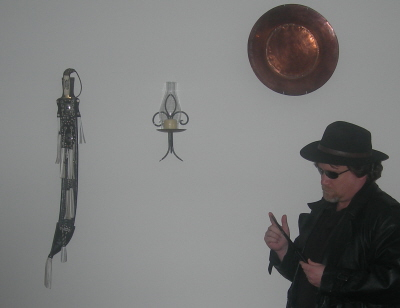|
About This Author
Come closer.
|
Complex Numbers
Complex Numbers
A complex number is expressed in the standard form a + bi, where a and b are real numbers and i is defined by i^2 = -1 (that is, i is the square root of -1). For example, 3 + 2i is a complex number.
The bi term is often referred to as an imaginary number (though this may be misleading, as it is no more "imaginary" than the symbolic abstractions we know as the "real" numbers). Thus, every complex number has a real part, a, and an imaginary part, bi.
Complex numbers are often represented on a graph known as the "complex plane," where the horizontal axis represents the infinity of real numbers, and the vertical axis represents the infinity of imaginary numbers. Thus, each complex number has a unique representation on the complex plane: some closer to real; others, more imaginary. If a = b, the number is equal parts real and imaginary.
Very simple transformations applied to numbers in the complex plane can lead to fractal structures of enormous intricacy and astonishing beauty.
February 13, 2023 at 12:01am February 13, 2023 at 12:01am
| |
Some of my blog entries can get kind of abstract. This is the opposite: concrete. It's one of those rare times when I get to talk about something I actually know a few things about.
Turns out 1000 years is an underestimate, in some of these cases.
Rome’s Pantheon stands defiant 2,000 years after it was built, its marble floors sheltered under the world’s largest unreinforced concrete dome.
Let's get this out of the way: cement is a component of concrete. It is not concrete. Calling a pavement, wall, or other concrete structure "cement" is common, but wrong. While one could make an argument that the usage is a form of synecdoche, it's a lame-ass synecdoche. Stop it.
For decades, researchers have probed samples from Roman concrete structures—tombs, breakwaters, aqueducts, and wharves—to find out why these ancient buildings endure when modern concrete may crumble after only a few decades.
They might endure even longer if scientists would stop coring them.
Not only is Roman concrete exponentially more durable than modern concrete, but it can also repair itself. Creating a modern equivalent that lasts longer than existing materials could reduce climate emissions and become a key component of resilient infrastructure, like seawalls.
You see a concrete structure, and you can be forgiven for thinking it's permanent. Well, as permanent as anything is, which is to say that even stone wears away over time. But we always figured on a 50 year lifespan for most concrete installations. Which I used to think was "forever," but I've lasted longer than that.
Concrete exposed to salt water can be even more ephemeral. The article does mention this later.
“We are dealing with extremely complex material,” says Admir Masic, a researcher at the Massachusetts Institute of Technology who led this new research on Roman concrete. “To kind of reverse-engineer or understand the original way these civilizations made this material is just a nightmare.”
What's worse is we have actual science to work with, and instruments that the Romans would have considered sorcery, and it's still been a chore to figure out. I can only assume they used trial and error to come up with their mixtures; what we're seeing now with Roman concrete is survivorship bias. I'd bet a lot of Roman concrete just isn't there anymore.
Until now, efforts to explain the longevity of Roman concrete have pointed to its use of volcanic tephra—the fragments of rock emitted in an eruption—mined in the Naples area and shipped to construction sites throughout the sprawling Roman empire.
Basic concrete, in our world, is essentially water, cement, and aggregate. You can add other things (admixtures). One of the most common when I was actually working with the stuff was fly ash. Fly ash is a very fine powder, a waste product of coal burning. It makes the mix more workable and lowers the production cost because you don't need to use as much cement. My only point here being that adding other stuff to concrete is very common.
But Masic and his MIT colleagues, along with researchers from Harvard and laboratories in Italy and Switzerland, suggest another reason: heat.
The curing of concrete (not "drying") is an exothermic reaction. Thus, it produces its own heat.
But what if the Romans used lime in a more reactive form, called quicklime, Masic wondered. When mixed with water, quicklime reacts and produces heat.
More heat.
Jackson also studied cores drilled from concrete in Roman harbors, determining that seawater moving through the concrete reacts with it to create new minerals that make the concrete more cohesive and resilient over time.
I gotta say, that's pretty impressive (though it was very likely a lucky accident). Like I said, salt water is bad for concrete. It's even worse for reinforced concrete, as not only does the matrix deteriorate, but the water then seeps in to the steel reinforcement, and you know what water does to (most) steel.
Roman concrete, in comparison, is strong, requiring no steel reinforcing it, unlike its modern counterpart.
Okay, I gotta quibble about this bit. I think what they mean has to do with applications that are compression-only, such as foundations, walls, sidewalks, streets. You put steel mesh in most of those situations to hold the concrete together after it cracks. But other uses for concrete, such as the floor/ceiling beams, are partly in tension, and no concrete can handle significant tension. So I think that's probably misleading.
Well, I've rambled on enough; as I said, it's one area I actually have some training in, though I wouldn't call myself an expert. I mostly wanted to point out that the Roman concrete wasn't the result of them being somehow smarter or more knowledgeable than we are, but largely a fortunate result of trial and error. Replicating that, or even approximating it, would certainly be cool. |
© Copyright 2025 Robert Waltz (UN: cathartes02 at Writing.Com). All rights reserved.
Robert Waltz has granted InkSpot.Com, its affiliates and its syndicates non-exclusive rights to display this work.
|

